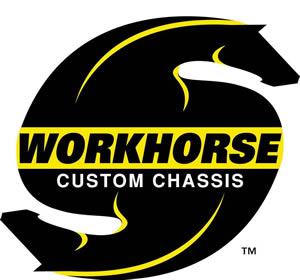Mountain driving: Let your engine do the Braking
This article provided by the Workhorse Chassis Technical Team
Workhorse has found that RV drivers often overheat and damage their vehicle braking systems by improper braking in mountain areas or by riding the brakes on flat ground. The following includes suggestions from the Workhorse Technical Team as well as recommendations outlined in the DOT (Department of Transportation) commercial drivers license manual. Workhorse has included these DOT procedures in its owners manual since 2007 and they apply to all types of motor homes.
In mountain driving, gravity plays a major role. On any upgrade, gravity slows you down. The steeper the grade, the longer the grade, and/or the heavier the load the more you will have to use lower gears to climb hills or mountains. In coming down long, steep downgrades, gravity causes the speed of your vehicle to increase. You must select an appropriate safe speed, and then use a low gear and proper braking techniques.
You should plan ahead and obtain information about any long, steep grades along your planned route of travel. If possible, talk to other motor home or truck drivers who are familiar with the grades to find out what speeds are safe. You must utilize engine braking techniques to go slowly enough so your brakes can be utilized for speed reduction without getting too hot. If the brakes become too hot, they may start to fade. This means you have to apply them harder and harder to get the same stopping power. If you continue to use the brakes hard, they can keep fading until you cannot slow down or stop at all.
Select a safe speed
 Your most important consideration is to select a speed that is not too fast for the:
Your most important consideration is to select a speed that is not too fast for the:
- Total vehicle and cargo weight.
- Length of grade.
- Steepness of grade.
- Road conditions.
- Weather.
If a speed limit is posted, or there is a sign indicating Maximum Safe Speed, never exceed the speed shown. Also, look for and heed warning signs indicating the length and steepness of the grade.
You must use the braking effect of the engine as the principal way of controlling your speed. The braking effect of the engine is greatest when it is near the governed rpms and the transmission is in the lower gears. Save your brakes so you will be able to slow or stop as required by road and traffic conditions.
Select the right gear before starting down the grade
Shift the transmission to a low gear before starting down the grade. Pay close attention to the gear that is required to climb the grade prior to decent. For example if the gear required to climb the grade is 3rd gear, then 3rd gear should be selected prior to the decent as a base line to control your vehicle speed. Do not try to downshift after your speed has already built up above the safe posted speed limit. Once your speed has increased over the safe posted speed limit you may not be able to shift into a lower gear. You may not even be able to get back into any gear and all engine braking effect will be lost.
With motor homes, a rule for choosing gears has been to use the same gear going down a hill that you would to climb the hill. However, new motor homes have low friction parts and streamlined shapes for fuel economy. They may also have more powerful engines. This means they can go up hills in higher gears and have less friction and air drag to hold them back going down hills. For this reason, drivers of newer motor homes may have to use lower gears going down a hill than would be required to go up the hill. Usually you want the lowest gear that will keep the motor home at or near the speed you want in negotiating the downhill. For example, if youre going down a six percent grade and wanted to go 35 mph, you would start downshifting and using the brakes to get to an engine rpm that will enable you to maintain a speed at or near 35 mph.
Proper braking technique
Remember, the use of brakes on a long and/or steep downgrade is only a supplement to the braking effect of the engine. Once the vehicle is in the proper low gear, the following is the proper braking technique:
- When your speed increases to or above your safe speed, apply the brakes aggressively enough to feel a definite slowdown.
- When your speed has been reduced to approximately five mph below your safe speed, release the brakes. (This brake application should last for about three seconds.)
- When your speed increases again to your safe speed, repeat steps 1 and 2.
For example, if your safe speed is 40 mph, you would not apply the brakes to any increase in speed until you reach 40 mph. Then you apply the brakes aggressively enough to gradually reduce your speed to 35 mph and then release the brakes. Repeat this as often as necessary until you have reached the end of the downgrade.
Brake fade or failure
Your brakes by design operate utilizing brake pads that rub against the brake disks to slow the vehicle during brake application. This braking function creates heat, which the brake system can dissipate during normal brake applications. However, brakes can fade or fail from excessive heat caused by improper use or dragging the brake to slow the vehicle on mountain grades rather than relying on the engine braking effect. To safely control a vehicle, every braking mechanism must do its share of the work. Brakes with excessively worn pads or rotors will not provide the same degree of braking power. If you are not sure about the condition of your braking system, have it inspected by qualified service center.
Escape ramps or runaway truck ramps
Escape ramps, also known as Runaway Truck Ramps, have been built on many steep mountain downgrades. Escape ramps are made to stop runaway vehicles safely without injuring drivers and passengers. Escape ramps use a long bed of loose, soft material to slow a runaway vehicle, sometimes in combination with an upgrade. Know escape ramp locations on your route. Signs show drivers where ramps are located. Escape ramps save lives.
You may also want to read: Brake-Friendly Driving Technique Tested in Death Valley

